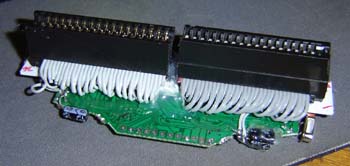This thread/project is pretty much over. I went into this project with a very basic knowledge of elctronics and circuts, and a friend that knew some more. We made mistkes along the way, and a general lack of NES knowledge ruined us. I had fun anyway and learned a bit, and now i'm in search for something I can afford (and am capable) of doing right.
Things accomplished Successfully:
Fixing a 72 pin connector
Disabling a 10Nes chip
Obtaining a NES ADVANTAGE controller in return for making a friends NES work again
Things botched:
No connector switch because I forgot how a circut works and I didn't read up enough on the archtecture of the NES
A few destroyed connectors
Uh, everything.
----------
--------------------------
Howdy all - I come to you in search of answers.
I have a new personal project that I thought up recently - I want to create a "Disc Changer" for my NES. That is, I want to create a unit with all of my NES games in it, label facing the user - with a button next to each label. When the NES on and the button is pressed, I want THAT cartridge to run on the console.
Of course, there are some problems with this - each game will need a 72 pin connector of it's own, or hopefully some sort of homemade substitue. The console itself may lose it's 72 pin connector, and have the outputs for the cartridges wired directly to the board.
There are lots of hurdels here, but the main one i'm concerend about is the 72 pin connector - I can't find very much information on the PIECE itself, even though I can find lots of information on replacing it, or "restoring" it by bending the pins back in place.
Are there any schematics avalible describing how it works? Do any hardware savvy folks here have any good ideas on how to go about making my own connectors (on the cheap) for the cartridges?
Are the TOP LOADER cartridge connector slots avalible for purchase anywhere?
I have one more question too - I'm probably going to need to buy a spare NES (or two) to do this project, but I also have a spare Famicom that i'm not using that I would be willing mod for this - are there any tutorials to modifying/replacing it's connector to work with NES games?
If this is too much to ask, i'm sorry - but i'm not sure where to start, and i'm starved for hardware information about the connector itself.
Things accomplished Successfully:
Fixing a 72 pin connector
Disabling a 10Nes chip
Obtaining a NES ADVANTAGE controller in return for making a friends NES work again
Things botched:
No connector switch because I forgot how a circut works and I didn't read up enough on the archtecture of the NES
A few destroyed connectors
Uh, everything.
----------
--------------------------
Howdy all - I come to you in search of answers.
I have a new personal project that I thought up recently - I want to create a "Disc Changer" for my NES. That is, I want to create a unit with all of my NES games in it, label facing the user - with a button next to each label. When the NES on and the button is pressed, I want THAT cartridge to run on the console.
Of course, there are some problems with this - each game will need a 72 pin connector of it's own, or hopefully some sort of homemade substitue. The console itself may lose it's 72 pin connector, and have the outputs for the cartridges wired directly to the board.
There are lots of hurdels here, but the main one i'm concerend about is the 72 pin connector - I can't find very much information on the PIECE itself, even though I can find lots of information on replacing it, or "restoring" it by bending the pins back in place.
Are there any schematics avalible describing how it works? Do any hardware savvy folks here have any good ideas on how to go about making my own connectors (on the cheap) for the cartridges?
Are the TOP LOADER cartridge connector slots avalible for purchase anywhere?
I have one more question too - I'm probably going to need to buy a spare NES (or two) to do this project, but I also have a spare Famicom that i'm not using that I would be willing mod for this - are there any tutorials to modifying/replacing it's connector to work with NES games?
If this is too much to ask, i'm sorry - but i'm not sure where to start, and i'm starved for hardware information about the connector itself.



